|
Dutch
Barn Preservation Society
Dedicated
to the Study and Preservation
of New World Dutch Barns
NEWSLETTER,
FALL 1991, Vol. 4, Issue 2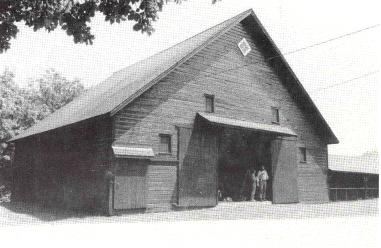
South
gable end of the Bronck Dutch barn. Photo by Peter Sinclair,
June 1991.
The Dutch Barn at the Bronck
Homestead
The Dutch Barn Preservation Society has been investigating the
barn and farm described in this article in response to an inquiry
about barn interpretation from the Greene County Historical Society,
which maintains and exhibits the Bronck Homestead complex at Coxsackie,
New York. The historic Bronck site, a National Historic Landmark
and a museum, retains a rural setting and contains two authentic
early Dutch houses as well as unique barns. The Vedder Memorial
Research Library is also at the location. For information, contact
the Greene County Historical Society, RD, Coxsackie, NY 12051.
A well-maintained Dutch barn forms part of the building complex
at the Bronck Homestead. A variety of alterations and the re-use
of older barn materials indicates the barn has had a complex history.
However, it stands as a representative example of the New World
Dutch barn type, using the traditional Dutch barn framing arrangement,
with deep anchor beams supported by columns. It has a center threshing
floor with flanking aisles, and includes a typical wagon entrance
and a stock door in one gable end. The weight of the large roof
is carried on the purl ins linking the columns. Such "aisled" barns,
although having origins in the culture of northern Europe, emerged
as perhaps the first distinct American barn form. They fulfilled
agricultural needs for crop storage, work space and animal shelter
on seventeenth and eighteenth century farms in the Hudson Valley
and adjacent areas molded by Dutch settlement.
In the Hudson River area south of Albany, where the Bronck barn
is located, early farms emphasized wheat production as a cash crop.
Other grains and garden produce were raised for farm and home use.
Light draft horses were the most frequent choice for farm work
and travel; a few cows were kept for milk and butter. Travelers
noted that "Albany wheat" brought a premium on the New
York market. The cut, unthreshed wheat, as well as other grains
and hay, was traditionally stored on sapling poles reaching from
anchor beam to anchor beam, above the threshing floor in a Dutch
barn. From there it could be taken down to be threshed during the
winter.
In common with many other farms occupied by Dutch settlers or
their descendants, the Bronck farm reflected the persistence of
European influence. The farm was controlled for over two and a
half centuries by a family which, although not initially of Dutch
origin, took its cultural identity as early as the seventeenth
century from the social and agricultural milieu established by
Dutch settlement. The Bronck farm was established after Pieter
Bronck obtained land from local Indians in 1662. According to family
tradition, the older part of the historic stone house still situated
on the farm was erected in 1663 in conjunction with the establishment
of the farm. Some years later, in 1738, a second house, built to
accommodate family members, was erected next to the stone house.
The farm remained in the Bronck family until the twentieth century,
when Leonard Bronk Lampman left the farm to the Greene County Historical
Society. Although some family records have survived, no clue to
the building date for the present Dutch barn on the site has been
found.
The barn, when constructed, appears to have incorporated older,
previously used anchor beams from another, possibly very early,
barn. Moreover, the construction date for the present barn may
be relatively late for a Dutch barn, possibly in the early 1800's,
a tribute to the cultural persistence of this type of barn framing.
The first decades of the nineteenth century were ones of "prosperity
and refurbishing of dwellings, a time when you get a sense of increased
activity on many fronts around the homestead,"
according to Shelby Kriele, Curator of the site. A double anchor
beam which provided an inserted floor for extra hay space at the
rear of the barn, an off-center door, and paired, sawn braces distinguish
the Bronck barn from earlier examples; these modifications suggest
an emphasis on hay production more characteristic of the nineteenth
century than of the eighteenth.
By the time this particular barn was erected, Albany and nearby
communities had grown rapidly in population. The regional need
for more dairy products, which, in turn, required the stabling
of more cows and extra hay production and storage, caused occasional
modifications to be made in the typical Dutch barn layout. Such
minor revisions, as well as barn additions, became common as area
agriculture changed. However, farmers in old families clung to
tradition and were reluctant to adopt totally different barn types
better adapted to hay storage. They preferred to adjust the old
form with which they were familiar. The Bronck farm was typical.
An oil painting by Richard William Hubbard (1816-1888) shows the
Bronck farm in this mid-nineteenth century farm mode when dairying
was important. (For a discussion of the timing and types of some
typical Dutch barn changes, see "Agrarian Changes: Learning
from Barn Additions," by Neil Larson, in the Fall, 1988, Dutch
Barn Preservation Newsletter.)
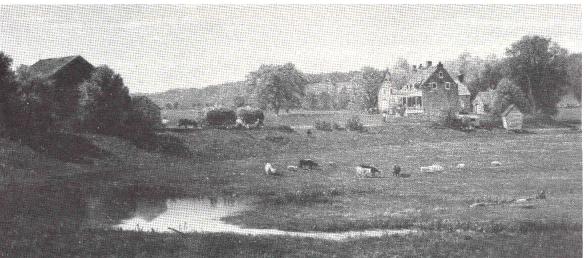
A luminous, anecdotal farm scene in oil on canvas
by Richard William Hubbard (1816-1888) shows the family, servants,
houses and Dutch barn at the Bronck farm in the nineteenth century.
Photo courtesy of the Greene County Historical Society.
The Bronck barn as it exists today also contains several much
later alterations, such as added side wagon doors, roof overhang,
and ventilating windows, reflections of further changes in society
and agriculture in the late nineteenth century and early twentieth
century when the Bronck farm commenced commercial hay production.
It is clear that the Bronck farm went through agricultural and
social changes typical of eastern New York State. These economic
transformations reflected the state's population growth and transportation
advances, as well as scientific and ideological strides in the
northeast.
The Bronck barn measures 48' 6" across the front and is
49' 3"
deep (outside measurements), common dimensions for a representative
Dutch barn in upper New York State. The present exterior siding
is not original. Earlier siding is shown in an illustration of
the barn which appears in the 1884 History of Greene County,
New York J. B. Beers &
Co.). This illustration of 1884 showed three martin holes in the
front (south) gable of the barn which are no longer there, as well
as an off-center door which has since been moved over to the center
of the front facade, where it now lines up with the center spline
of the threshing floor. This latter location would have been the
expected location. However, evidence of the original off-center
door location is retained in a centerpole mortise above the opening
and in the location of mortises for now-missing door supports.
The Richard William Hubbard oil painting of the barn, mentioned
above, shows the rear, or north, wall of the barn, with the traditional
martin holes at the peak. Nearby are two wagon loads of hay, probably
harvested solely for use on the farm and intended to be stored
as loose hay. The haying was being done by family members and servants
who were working to get the crop under cover at the right moment.
The Bronck farm had by that time evolved from the earlier Dutch
model, and maintained a larger number of cows for production of
cash crops of milk, butler and cheese. To accommodate these cows,
more barns had been erected on this prosperous farm. Some milk
may have been offered for sale at Albany, with butler or cheese
going downriver. Major wheat production had moved west to other
regions of the state. No doubt the farm was still relatively self-sufficient.
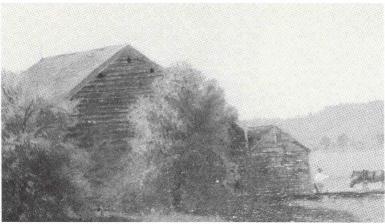
This detail from the nineteenth century Richard
William Hubbard painting of the Bronck farm reveals old siding
with martin holes in the rear gable of the barn. A tree and a
stream are located behind the barn, with a small building on
the right. Photo by Peter Sinclair.
The Dutch barn, as it exists today, contains evidence that the
situation had changed by the end of the nineteenth century. The
older siding was replaced with the novelty siding which is on the
barn at present. This siding has no martin holes but includes a
diamond-shaped window at the peak and four framed rectangular openings
on the front and rear gable ends. These ventilating openings are
located precisely at side aisle and center hay loft levels. (See
photos.) Additional framed openings line the side walls along the
hay storage space. The "windows" can be opened from inside
the barn by raising wooden panels seated in slots. An old photograph
shows that ventilating windows and the Victorian roof detail added
to the existing Dutch barn match those in a very large specialized
hay barn built nearby on the Bronck farm. The Dutch barn had been
converted into one unit of a commercial hay storage complex. The
old Dutch barn's remodeling, and the presence of the large additional
barn solely for hay storage, in addition to five teams of horses,
each with a teamster, indicates that production of extra hay to
sell at the farm had become a major venture. Large adjacent farms
were also rented by the family for hay production.
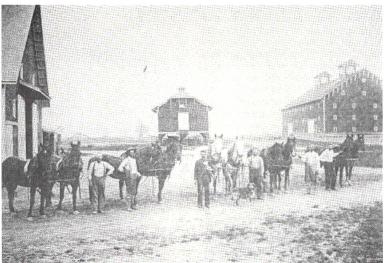
Old photo shows Dutch barn at left, with large
barn for hay storage at right in former pasture. Hay from the
large barn was baled and sold for shipment downriver. Both barns
are still standing, although the larger barn is not part of the
historic site. Ventilating windows, similar to those in the big
hay storage barn at right, and a new roof with an overhang were
added to the Dutch barn. The corn crib with clipped gable seems
to be the same one shown in the 1884 depiction. The corn crib
was later moved away to be made into an early gas station. Courtesy
Vedder Library, Greene County Historical Society, copy of photo
by Shirley Dunn.
Stylish cupolas, late-Victorian brackets, framing around windows
and fresh paint all bespeak an ability to keep up with the styles
and tastes of the period, reflecting the family's prosperity. One
source was the farm. In the period from 1885 to 1925, hay barges
pulled by tugboats took on baled hay and straw at Hudson River
landings to supply fodder and bedding for the delivery horses of
burgeoning New York City, and the Bronck farm was participating
in this trade. Hugh Van Orden, a Society member and longtime Greene
County farmer, remembers unloading loose hay into the larger barn
shown at right in the old Bronck photo. Later, the hay was baled
for removal to nearby Hudson River landings, where it was loaded
on the hay barges.
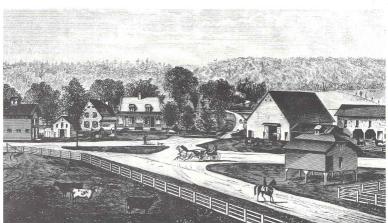
Depiction of the Bronck Farmstead in the 1884 History
of Greene County, New York (J.B. Beers & Co.) includes the
Dutch barn. The view of the south facade shows martin holes,
aisle doors, and off-center wagon doors, and a wagon shed addition
at right. The finial or weather vane on the peak of the barn
may be the same one shown in Hubbard's painting. The scene includes
the corn crib, carriage house and other outbuildings to house
the livestock on the farm. Cattle graze where a large hay storage
barn was later built.
The present roof and the overhanging eaves, in addition to the
siding, have been added to the Dutch barn since the 1884 illustration
was made. Another change, again an accommodation for hay, was made
when wagon doors in both the east and west walls were added and
floor planks were installed at each new entrance to serve as wagon
runways. There are several reasons for believing the side doors
are late nineteenth or early twentieth century additions. The doors
are not suggested in the 1884 illustration. In the mid-nineteenth
century painting of the farm, a small building is shown directly
in the way of any exit on the west side, making a door there unlikely.
In addition, these added doors slide on tracks, were never swinging
doors, and were installed with post 1850 nails. There is also clear
physical evidence inside the barn that the doors were added. They
are in locations where there were formerly braces, wall studs and
a longitudinal connection. The installation of the side doors possibly
occurred about the same time the ventilating windows were added.
The added doors permitted a hay wagon to drive through from side
to side.
At the rear of the barn, the terrain slopes down to a meandering
stream. The sloping terrain is shown in the nineteenth century
Hubbard painting, and a tree at that time was located immediately
behind the center rear of the barn. This evidence suggests there
was no rear original set of wagon doors, a conclusion born out
by evidence on the interior back wall. Studs are in place there,
and no empty mortises or hinges suggest a former door opening.
Most significantly, the extra hay space occupying the rear bay
was supported by a dropped anchor beam too low to drive a wagon
under. This beam supported a hanging floor for extra hay storage.
 Older,
re-used anchor beams in the Bronck barn carry empty mortises
as well as holes for pegs of former braces. When the present
barn was erected, sawn pieces, installed in pairs, were used
as braces. Tongue of anchor beam at rear clearly shows holes
from former wedges, indicating the columns and anchor beams were
not originally mates. Photo by Harold Zoch, June 1991. Older,
re-used anchor beams in the Bronck barn carry empty mortises
as well as holes for pegs of former braces. When the present
barn was erected, sawn pieces, installed in pairs, were used
as braces. Tongue of anchor beam at rear clearly shows holes
from former wedges, indicating the columns and anchor beams were
not originally mates. Photo by Harold Zoch, June 1991.
Inside, the impressive spaces of the barn are intact. Long roof
rafters soar overhead. A threshing floor 25' wide, with a center
spline, extends 49' from the front to the rear of the barn. Side
aisles, slightly over 10' wide, flank the threshing floor on both
sides, in traditional Dutch barn fashion. Evidence of a built-in
manger remains, in the form of mortises and wear-marks, on the
west wall beside the threshing floor. Dove-tails of former floor
supports remain in the framing for the side aisles.
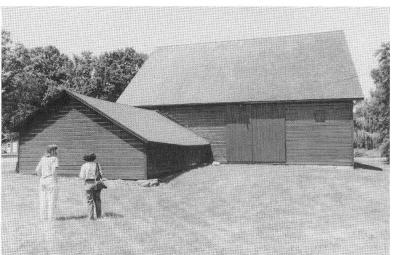
East wall of the Bronck barn shows inserted doors
and ventilating windows, added to improve use of the barn for
hay storage. Rear of wagon shed is at left. Photo by Peter Sinclair,
June 1991.
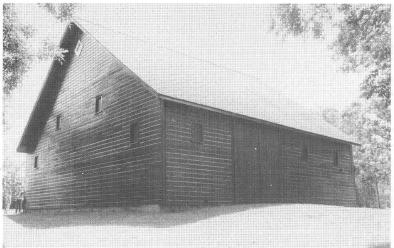
The Bronck barn showing north and west walls, with
diamond shaped window at peak, ventilating windows and added
doors. land slopes away at rear as it is shown in the painting
by Hubbard. Photo by Peter Sinclair, June 1991.
Three anchor beams of an average 20" depth span the threshing
floor and divide the barn into four bays. The two additional anchor
beams on the end walls are slightly smaller, as is typical. The
five anchor beams do not match their supporting columns, however.
The anchor beams have empty mortises for braces no longer in place.
Instead of the original heavy braces, lighter double braces made
of sawn lumber have been inserted to support the anchor beams.
(See photos.) These sawn braces are fitted to the present columns.
There are no empty mortises for former braces in the columns as
there are in the anchor beams, evidence that the columns and the
anchor beams were not originally mated. Moreover, the anchor beams
have been trimmed back, altering the original shoulder and permitting
the column to be moved a few inches toward the center. Empty wedge
holes show the location of the earlier columns. However, since
the present columns are in their correct position on the barn floor
and there is no evidence in the floor of the columns having been
moved, the barn appears to have been built with the existing frame.
The conclusion is that when the barn was built, very old anchor
beams from another barn were
obtained and modified for use with the new frame. These anchor
beams had the large size (20" by 12") associated with
earlier barns and had once had commensurately large posts to support
them. The nineteenth century trend was toward lighter frame members,
so the new columns used were lighter than the old ones. Interestingly,
one of the anchor beams has, on its west end, a wooden cleat nailed
on with three pre-nineteenth century rose-headed nails. The cleat
may have come to the barn with the old anchor beam. There are no
Roman numerals visible on the anchor beams or columns.
Fall
1991 Newsletter, part two.
|